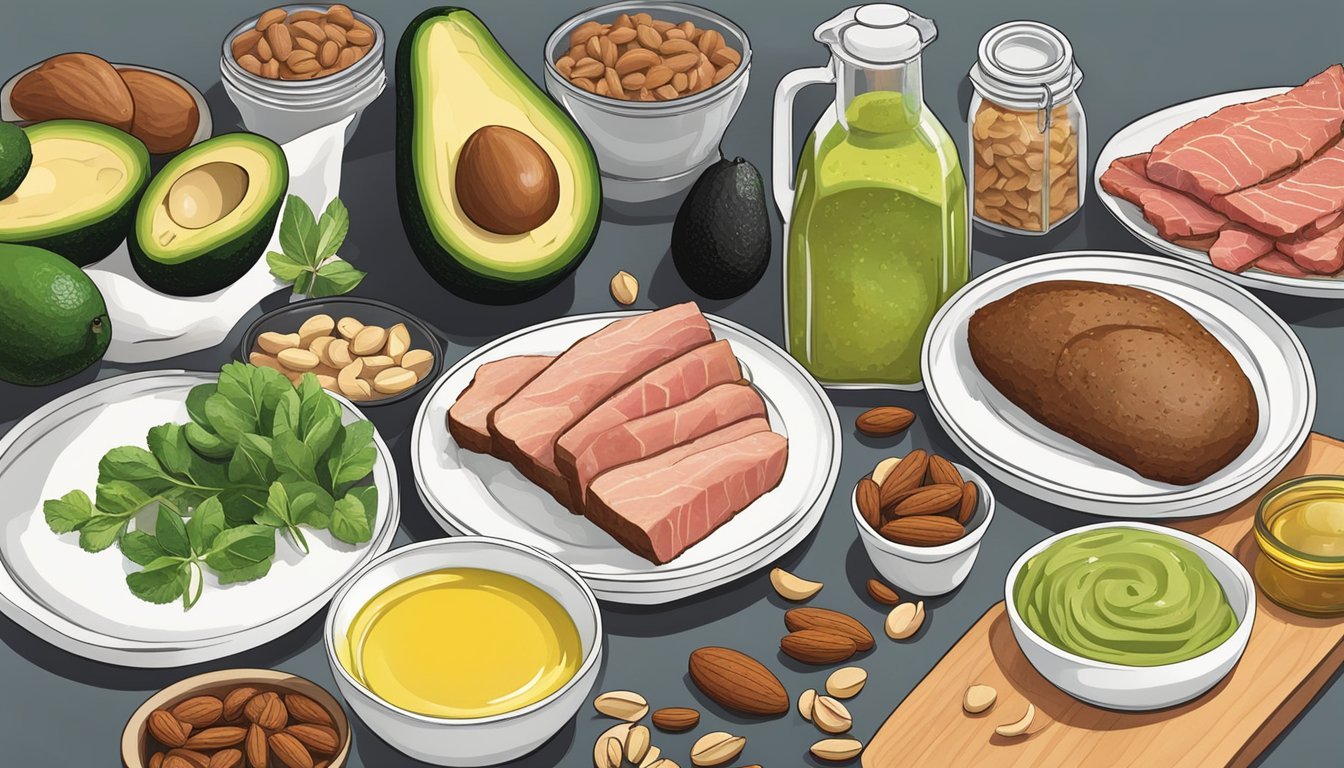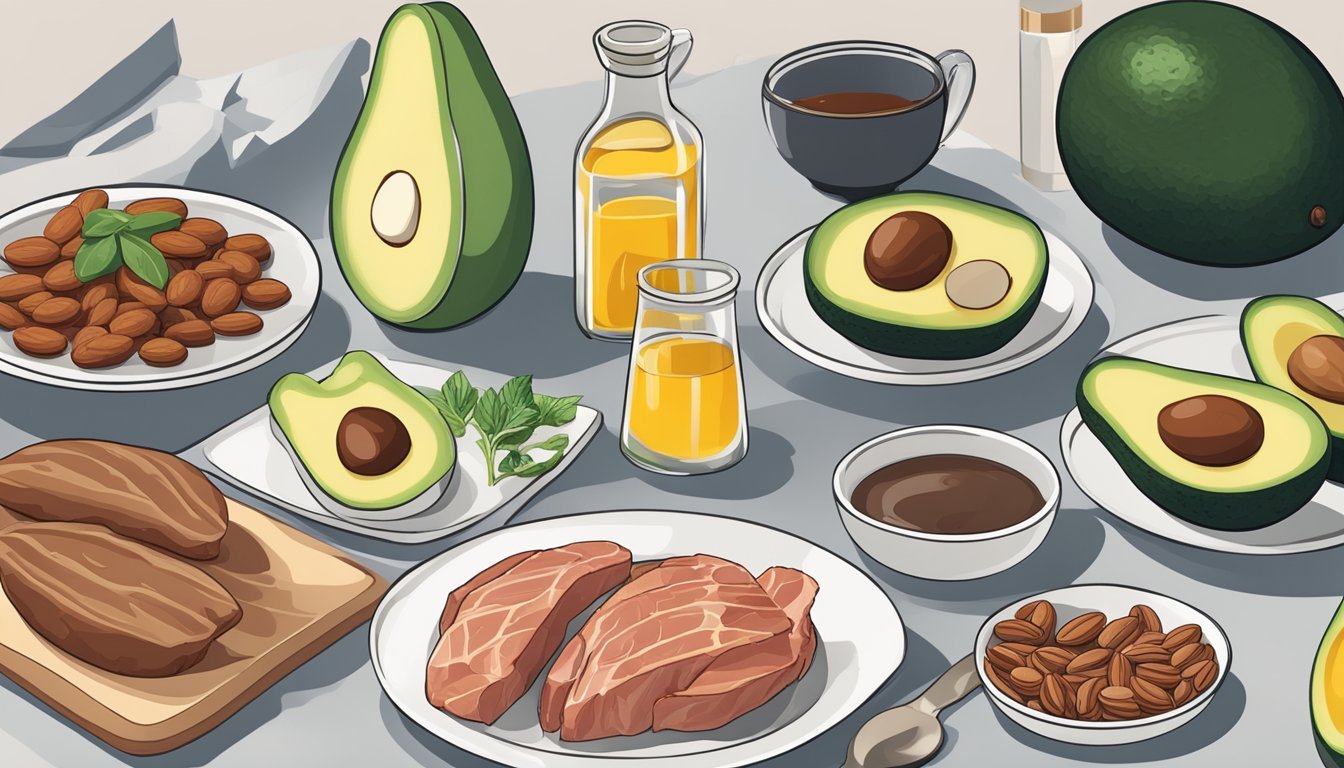High-Fat Diet Recipes for Beginners
Simple Steps to Get Started
Embarking on a high-fat diet, such as the ketogenic diet, marks the beginning of a substantial shift in how one approaches nutrition and meal planning. Contrary to popular belief, a diet rich in healthy fats does not necessitate a monotonous menu; instead, it offers a diverse range of satisfying and nutrient-dense foods. The ketogenic diet prioritizes fats as the main source of energy, significantly reducing carbohydrate intake to encourage the body to burn fat for energy. This dietary adjustment often results in a steady supply of energy and can lead to weight loss for many individuals. Overall, by employing strategic use of fats from sources like avocado, cheese, and nuts, a high-fat diet can be both nutritionally fulfilling and enjoyable.
When preparing high-fat recipes for beginners, it's crucial to focus on incorporating a variety of fats that support health. Avocado, for example, brings not only creaminess and flavor to dishes like deviled eggs but also provides essential nutrients without relying on dairy. The versatility of fat-rich ingredients enables people to construct meals that are flavorful, satisfying, and aligned with nutritional goals. Understanding the macronutrient breakdown of meals is equally important, ensuring that one's dietary intake remains within the desired range for fats, proteins, and carbohydrates.
For those new to a high-fat, ketogenic lifestyle, the shift can seem daunting at first. However, with a vast array of recipes and meal plan options available, beginners can easily transition to this diet without sacrificing taste or variety. With the appropriate guidance and a focus on high-quality, fat-rich foods, meals can be crafted that not only adhere to the diet's principles but also support an overall healthy lifestyle.
Understanding the Basics of a High-Fat Diet
When starting a high-fat diet, it is essential to understand its composition and its potential benefits and risks to health. An abundance of dietary fat and minimal carbs are the hallmarks, aiming to induce a metabolic state known as ketosis.
Defining a Ketogenic Diet
A ketogenic diet is characterized by a macronutrient distribution heavily weighted towards fats, which typically make up around 70-90% of total daily calories. Protein intake is moderate, while carbohydrate consumption is drastically reduced to about 5-10% of daily calories.
The Role of Carbs and Fats in Keto
In a ketogenic diet:
Carbohydrates are minimized to deplete the body's glucose reserves.
Fats become the primary energy source, resulting in the production of ketones by the liver.
This shift away from carbs and towards fat and ketone bodies as fuel is a corner-stone of the keto diet.
Health Benefits and Risks
Health benefits of a ketogenic diet include:
Weight loss: Studies suggest a keto diet may assist in reducing body fat.
Diabetes and blood sugar control: It can improve insulin sensitivity.
Neurological conditions: There is evidence supporting benefits for epilepsy, Alzheimer’s disease, and other neurological disorders.
Risks may include nutrient deficiencies and increased heart disease risk due to high saturated fat intake. It's important to choose healthy fats and maintain nutritional adequacy.
How Ketosis Works
Ketosis is a metabolic state where the body, in the absence of sufficient carbohydrates:
Produces ketone bodies, which serve as an alternative energy source for the brain and other organs.
Achieving ketosis typically requires several days of strict carbohydrate restriction.
Getting Started with Keto
Transitioning to a ketogenic diet can be smooth with the right preparation. This guide will set beginners on the path to understanding the essentials for a successful keto meal plan, including shopping effectively, managing macronutrients, and maintaining proper hydration.
Keto Diet Plan Basics
The ketogenic diet emphasizes high-fat intake, moderate proteins, and very low carbohydrates to achieve a metabolic state known as ketosis. When in ketosis, the body burns fat for fuel instead of glucose. A standard keto meal plan heavily features foods such as dairy products, seafood, avocados, and leafy greens. Recipes crafted for keto diets will typically substitute common high-carb ingredients for more nutritional, low-carb alternatives.
Grocery Shopping Tips for Keto Beginners
When shopping for a keto diet, beginners should focus on unprocessed foods and avoid items with added sugar or starch. Here's a brief list of keto-friendly options to consider:
Proteins: Choose fatty cuts of meat, poultry, and seafood.
Dairy: Opt for high-fat dairy products like cheese and butter.
Fats & Oils: Select sources like olive oil and coconut oil.
Vegetables: Prioritize leafy greens and above-ground vegetables.
Snacks: Look for nuts, seeds, and low-carb berries.
Careful label reading is necessary to avoid hidden carbs often found in processed foods.
Understanding Macros and Net Carbs
Macros, short for macronutrients, refer to fats, proteins, and carbohydrates. On keto, one aims for high fat (roughly 70% of daily calories), moderate protein (about 20%), and minimal carb intake (around 5-10%). Net carbs are the total carbs minus fiber and are the key carbs to track on a keto diet. Staying within 20-50 grams of net carbs per day is typically recommended to maintain ketosis.
The Importance of Hydration and Electrolytes
Hydration is crucial on a keto diet as the body adjusts and begins to deplete glycogen stores, which also store water. Drink plenty of water, and consider hydrating drinks like tea or coffee, minus the sugar. Balancing electrolytes like sodium, potassium, and magnesium is necessary to avoid the "keto flu," a common early side effect when starting the diet. This helps maintain energy levels and proper body functions.
Essential Keto-Friendly Foods
Embarking on a ketogenic diet entails prioritizing foods that support a state of ketosis. This high-fat, moderate-protein, and low-carbohydrate regimen focuses on whole, nutrient-dense ingredients.
Top High-Fat Ingredients
Nutrient-rich, high-fat foods are the cornerstone of keto diets. Here are the ones you should keep at the top of your grocery list:
Olive oil and coconut oil: Staple sources of healthy fats for cooking and dressings.
Avocado: High in monounsaturated fats and full of nutrients, it’s ideal for salads or as a topping.
Nuts and seeds: Packed with fats, fiber, and protein, options like almonds and chia seeds are keto-friendly.
Low-Carb Vegetables and Fruits
Selecting low-carb vegetables and fruits ensures you maintain ketosis while obtaining essential vitamins and minerals:
Leafy greens like spinach and kale: Low in carbohydrates, high in fiber.
Berries: Small servings of strawberries or raspberries provide flavor without too many carbs.
Best Protein Sources on Keto
On a ketogenic diet, the focus on protein sources is careful to ensure they are both high-quality and not too high in carbs:
Eggs: Hailed for their versatility and nutrient profile; they’re a keto essential.
Fish especially fatty fish like salmon: Offers healthy omega-3 fatty acids and is virtually carb-free.
Cheese: Opt for hard, aged cheeses for a high-fat, low-carb protein addition.
Fats to Embrace and Those to Avoid
Fats are not created equal, and choosing the right kinds can mean the difference between a healthy keto lifestyle and an unhealthy diet:
Embrace: Saturated fats from eggs and fish, monounsaturated fats like those found in olive oil, and some saturated fats such as coconut oil.
Avoid: Trans fats usually found in highly processed foods and certain margarines. Also, minimize the intake of oils high in omega-6 fatty acids, such as sunflower or corn oil.
Preparation and Cooking Techniques
Adopting a high-fat, low-carbohydrate lifestyle can be simple with the right preparation and cooking techniques. This section provides beginners with the essential skills for successfully executing keto recipes, ensuring healthful and budget-friendly meal preparation.
Keto Cooking Essentials
For anyone starting a ketogenic diet, understanding the essentials in the kitchen is crucial. They should stock up on high-quality fats such as avocado oil, coconut oil, and grass-fed butter. Having a variety of spices and fresh herbs at hand helps in adding flavor without the carbs. It's also important to have non-stick cookware and silicone baking mats for easy cooking and cleanup.
Meal Prep for Beginners
Meal prep is a time-saving strategy where beginners cook meals in advance, which supports diet adherence. They should start by prepping keto-friendly vegetables and protein sources for the week. Beginners might benefit from using meal prep containers to portion and store their meals properly, ensuring they stick to their macro goals.
Using an Instant Pot for Keto Recipes
The Instant Pot is a versatile tool for those following a keto diet. Its ability to sauté, steam, and slow cook makes it ideal for preparing tender meats and stews, which are staples of a high-fat diet. Beginners can quickly cook large batches of recipes like keto chili or shredded chicken, which can be used in various meals throughout the week.
Budget-Friendly Keto Cooking
Keto cooking can be economical when one knows how to shop and cook smartly. They should buy keto staples like eggs, cheese, and seasonal vegetables in bulk. Using less expensive cuts of meat and enriching them with healthy fats such as olive oil or butter is another way to keep meals both budget-friendly and delicious. Simple and affordable tools like a slow cooker can also be utilized for economical keto cooking, preparing satisfying meals with minimal effort.
Delicious High-Fat Keto Recipes
For those beginning a high-fat, low-carb keto diet, finding a variety of tasty recipes is essential for maintaining the diet long-term. Below are recipes specifically chosen for their flavor and nutritional value, providing the fats needed for energy while keeping blood sugar levels in mind.
Keto Breakfast Ideas
Avocado Deviled Eggs: An excellent way to start the day is with Avocado Deviled Eggs. They provide healthy fats without dairy, incorporating nutrient-dense avocado.
Cauliflower Keto Bread: Bread lovers can savor the taste of a Cauliflower Crusted Grilled Cheese Sandwich—a delicious keto bread alternative, pairing well with white cheddar.
Satisfying Keto Lunches
Big-Ass Keto Salad: For a refreshing midday meal, one can never go wrong with a Big-Ass Keto Salad. It's loaded with various greens, proteins, and a high-fat dressing for fullness.
Bison (What wine goes well with bison?) Chili: A hearty option like Bison Chili can provide energy for hours. It's rich in protein and fats, keeping one satiated and in line with keto goals.
Keto Dinner Inspirations
Pork and Asparagus (how long does asparagus last?) Stir-Fry: For dinner, a Pork and Asparagus Stir-Fry is both easy to cook and rich in flavors. Avoid adding rice to keep it keto-friendly.
Garlicky Roast Chicken: Another nutritious dinner choice is Garlicky Roast Chicken, which can be served with a side of broccoli for a fulfilling and balanced meal.
Keto Snacks and Side Dishes
Bacon-Asparagus Dippers: These Bacon-Asparagus Dippers are easy to prepare and perfect for those needing a quick, delicious snack that aligns with the keto diet.
Vegetarian Egg Bites: For a snack high in fats and protein, Vegetarian Egg Bites with Cheddar and Bell Pepper or Egg Bites with Smoked Salmon and Dill offer taste without the guilt.
These recipes are a great starting point for anyone transitioning to a keto lifestyle, ensuring variety and enjoyment in every meal.
Overcoming Challenges in Keto Dieting
Adopting a keto diet can be rewarding, but beginners may face several challenges as their bodies adjust to ketosis. Understanding how to navigate these obstacles is crucial for a sustainable and healthy transition to this high-fat, low-carb diet.
Dealing with Keto Flu
The keto flu is a common challenge when starting a keto diet, as the body transitions from burning glucose to burning fat for energy. Symptoms may include fatigue, headaches, and irritability. To combat this:
Stay Hydrated: Increase water intake to help alleviate symptoms.
Electrolytes: Ensure a balanced intake of salts, particularly sodium, potassium, and magnesium, to maintain proper electrolyte levels.
Managing Hunger and Cravings on Keto
A keto diet can alter an individual's hunger signals and cravings due to changes in macronutrient intake. Here's how to handle these changes:
Plan Meals: Prepare keto-friendly meals ahead of time to prevent unplanned carb intake.
Healthy Fats: Include sources of healthy fats like avocados and nuts to increase satiety.
Protein: Consuming adequate protein helps curb hunger and preserve muscle mass.
Staying Keto while Eating Out
Eating out on a keto diet requires mindfulness to avoid hidden carbs. They should:
Menu Research: Check restaurant menus ahead of time to find keto-friendly options.
Customize Orders: Don't hesitate to ask for modifications, like substituting starchy sides with extra vegetables.
By taking proactive steps, individuals can overcome common challenges associated with starting and maintaining a successful keto diet.
Advanced Keto Topics
In the pursuit of a ketogenic lifestyle, certain techniques and considerations can further enhance the diet's effectiveness for weight loss and metabolic health. This section delves into complementary practices and tailored approaches for specific groups.
Intermittent Fasting and Keto
When one combines the ketogenic diet with intermittent fasting, they may experience accelerated ketosis and potentially more significant weight loss. Intermittent fasting involves cycling between periods of eating and fasting, which can extend the time the body spends in a fat-burning state. This synergy may amplify the production of ketones, compounds that are central to the ketogenic diet's function.
The Impact of Keto on Special Populations
Special populations, including those with health conditions, should consider the ketogenic diet's nutritional profile with careful attention. Studies have shown that a ketogenic diet can affect various conditions differently. For instance, it might improve metabolic health in individuals with type 2 diabetes but may require adaptation for those with thyroid or adrenal issues. Consulting with a healthcare provider is crucial before they begin a ketogenic diet.
Long-Term Sustainability of the Keto Diet
Balancing nutrition and enjoyment is key to sustaining a ketogenic diet long-term. Individuals should focus on a variety of healthy fats and proteins to maintain dietary adherence without nutrient deficiencies. They should also consider the diet's impact on social settings and personal satisfaction, which plays a role in the long-term feasibility of any diet, including keto. Regularly reviewing the latest nutrition studies keeps one informed about how to optimize and sustain their ketogenic lifestyle.
Conclusion
Transitioning to a high-fat diet such as keto requires careful consideration of nutrition, especially for beginners. A rich variety of recipes that include healthy fats are essential. They not only contribute to potential weight loss but can also support a healthy lifestyle.
Incorporating foods like avocados, berries, and eggs ensures a diverse intake of nutrients while adhering to diet requirements. Meal planning is crucial; it helps maintain a balance of macros and aids in avoiding high-carb temptations.
One must be vigilant about their food choices to gain the lifestyle and health benefits—reduced risk of heart disease, improved metabolic health—that this diet promises. As with any change in diet, consultation with a healthcare provider is recommended to ensure it aligns with individual health needs and goals.
Moreover, the recipes chosen should not only aim at weight loss but nourish the body. It's more than a diet; it's about long-term changes in eating habits. Enthusiasts claim improvements in energy levels and mental clarity, benefits that complement the healthy fats intake.
Remember, this is not a one-size-fits-all approach. It should be tailored to each individual's needs, ensuring nutrition is not compromised. This diet's efficacy varies per individual, and one's adherence to the diet significantly impacts its success.







